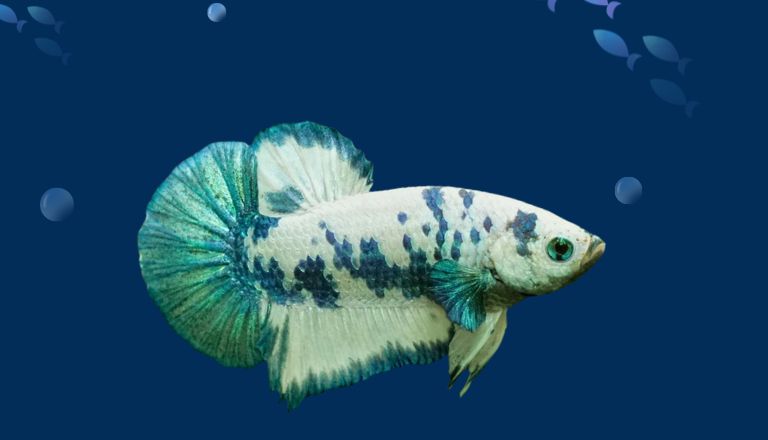Dalmatian Betta Fish Care Guide & Species Profile
Dalmatian Bettas, adorned with striking black spots reminiscent of the iconic dog breed, is a captivating addition to any aquarium. With their distinctive appearance and charming personality, these unique fish stand out among other Betta varieties. In this comprehensive guide, we delve into the world of Dalmatian Betta to provide you with all the essential information needed to ensure their health and happiness in the tank.
Dalmatian Betta Facts & Overview
Dalmatian Betta fish are captivating creatures known for their unique patterns. Their care level is moderate. They require a well-maintained tank with stable water parameters. Dalmatian Bettas can exhibit varying behaviors.
These striking fish come in a wide range of colors. With proper care, these beautiful Bettas can live up to 3-5 years. Dalmatians enjoy a varied meal plan consisting of high-quality pellets, freeze-dried bloodworms, and occasional live snacks like brine shrimp.
Appearance
This unique variety of Betta fish, distinguished by its white body speckled with black spots reminiscent of a Dalmatian dog, is a favorite among aquarium enthusiasts for its eye-catching appeal. These distinctive markings add a playful charm to the already captivating beauty of the Betta fish, making them stand out in any collection.

Dalmatian Bettas also display a wide range of colors and tail variations. From vibrant reds and blues to iridescent greens and purples, each Dalmatian Betta showcases a mesmerizing palette. Their flowing fins come in different shapes and sizes, which enhance their graceful movements.
Behavior
The Dalmatian Betta displays a unique behavior. These fish are active and curious. They have a playful nature.
Dalmatian Bettas tend to flare their fins at perceived threats or during territorial disputes. This aggressive posturing is an instinct in Betta fish. Dalmatians are generally peaceful towards other tank mates, which makes them suitable for community tanks with non-aggressive species.
Dalmatian Bettas also have a habit of building bubble nests near the water’s surface. These nests serve as breeding sites for spawning pairs, indicating that your Betta is happy and healthy in its environment.
Habitat and Tank Requirements
These striking fish require a tank size of at least 5 gallons, with plenty of plants and hiding spots to mimic their natural environment. Ensure the tank has ample space for them to swim freely without getting stressed.
Maintain water quality for the health of Dalmatian Bettas. Regularly Change the water, add a well-functioning filtration system, and keep the temperature stable to create an ideal environment for these beautiful creatures.

Add floating plants or smooth substrate to replicate their native habitats and provide enrichment in the tank.
Tank Conditions
These beautiful fish thrive in temperatures ranging from 75-82°F (24-28°C) and prefer slightly acidic to neutral pH levels between 6.5-7.5. They are sensitive to water hardness levels, so maintain a hardness level between 5-15 dGH.
Compatibility and Tankmates
Peaceful community fish like Tetras or Rasboras are good companions for these beautiful Bettas. Ensure plenty of hiding spots and plants in the tank to create separate territories for each fish and reduce potential conflicts.

You can opt for peaceful bottom-dwellers such as Corydoras Catfish or small non-aggressive snails.
Tankmates (To Avoid)
Avoid aggressive or fin-nipping fish that can stress or harm your betta. Avoid adding brightly colored fish with long fins, like Male Guppies or Fancy Goldfish, which may trigger aggression in your Betta. Also, avoid fast-swimming and territorial fish such as Barbs or Cichlids as they can outcompete the slower-moving Betta for food and resources.
Diet and Feeding Requirements
These fish are carnivorous by nature. Provide them with a protein-rich diet. Add high-quality pellets and flakes specifically designed for bettas in their meals.
Dalmatian bettas can also benefit from occasional treats such as bloodworms, brine shrimp, and daphnia. These live or frozen foods mimic what they eat in the wild, and provide essential nutrients and variety to their diet.
Avoid overfeeding these fish, as they are prone to obesity which can lead to various health issues. By offering a balanced and varied diet, Dalmatian bettas can thrive and display their best colors for years to come.
Breeding
Breeding Dalmatian Betta fish requires careful attention to detail. Breeders selectively pair individuals with desirable traits and colors. This selective breeding process results in offspring displaying varying degrees of the Dalmatian pattern.

Provide optimal conditions for the development and care of both the parent fish and their offspring. Provide adequate tank space, proper water parameters, and a balanced diet. Closely observe the mating behaviors and carefully monitor the fry growth to ensure successful breeding outcomes.
Conclusion
Dalmatian Betta fish care requires attention to detail and a commitment to provide a suitable environment. By understanding the unique needs of this species, such as water temperature, tank size, and feeding requirements, you can ensure the health and well-being of your pet.
Monitor water quality regularly and make adjustments as needed to maintain optimal conditions. With proper care and dedication, your Dalmatian Betta can thrive and bring joy to your home for years to come. Take the time to create a safe and enriching habitat for your fish – they will reward you with their vibrant colors and playful personalities.
FAQs
How Often Should I Feed My Dalmatian Betta?
You can feed your Dalmatian Betta in small amounts multiple times a day. It is recommended to feed your Dalmatian Betta 2-3 times a day. Each feeding session consists of just a few pellets or flakes. Avoid overfeeding as it can lead to health issues such as obesity and water quality problems in the tank.
Can Dalmatian Bettas Live With Other Fish?
Dalmatian Bettas are territorial by nature and may exhibit aggression towards other fish, especially those with long fins or bright colors. If you want to keep a Dalmatian Betta with other fish, choose peaceful tank mates. Small, non-aggressive species such as Corydoras catfish or Neon tetras can be good companions for Dalmatian Bettas.
What Are Common Health Issues That Affect Dalmatian Bettas?
One common health issue in Dalmatian bettas is fin rot, which is a bacterial infection that causes the fins to become ragged and discolored. Another health issue that Dalmatian Bettas may face is swim bladder disorder, which can cause difficulty swimming or floating upside down. This condition can be caused by overfeeding or poor water quality.
How Long Do Dalmation Bettas Live?
Dalmatian Bettas have an average lifespan of 2-3 years. With proper care and a healthy environment, they can live up to 4-5 years. Provide them with a suitable tank size, clean water, and a balanced diet to ensure their longevity.







